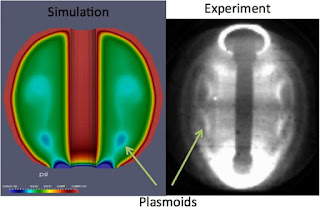 |
| Left: Plasmoid formation in simulation of NSTX plasma during startup without solenoid. Right: Fast-camera image of NSTX plasma shows two discrete plasmoid-like structures. Credit: NSTX |
Topics: Applied Physics, Nuclear Fusion, Plasma Physics, Research
The tokamak is an experimental chamber that holds a gas of energetic charged particles, plasma, for developing energy production from nuclear fusion. Most large tokamaks create the plasma with solenoids—large magnetic coils that wind down the center of the vessels and inject the current that starts the plasma and completes the magnetic field that holds the superhot gas in place. But future tokamaks must do without solenoids, which run in short pulses rather than for weeks or months at a time as commercial fusion power plants will have to do.
Recent computer simulations have suggested a novel method for launching the plasma without using solenoids. The simulation modeling shows the formation of distinct, current carrying magnetic structures called plasmoids that can initiate the plasma and complete the complex magnetic field.
Everything starts with magnetic field lines, or loops, that rise through an opening in the floor of the tokamak. As the field lines are electrically forced to expand into the vessel, a thin layer, or sheet, of electrical current can form. Through a process called magnetic reconnection, the sheet can break and form a series of ring-shaped plasmoids that are the magnetic equivalent to the bubble rings created by dolphins.
Phys.org: Launching fusion reactions without a central magnet, or solenoid
Comments